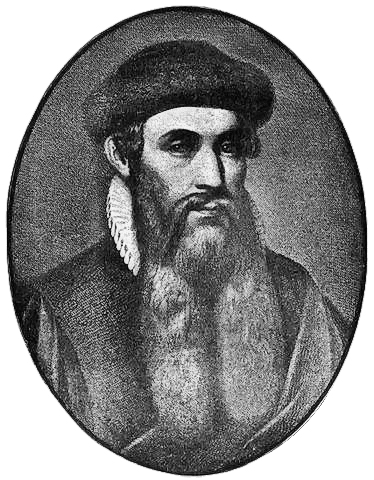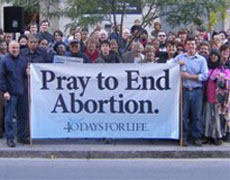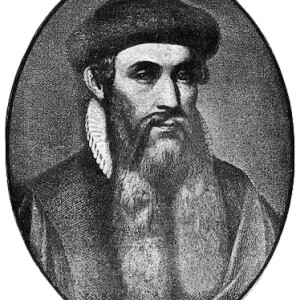 |
| A Well-Bearded Gutenberg. |
In 1439, a German blacksmith named Johannes Gensfleisch zur Laden zum Gutenberg changed the world forever. Better known simply as Johannes Gutenberg, he invented the printing press, which had an enormous (and largely unintentional) impact on Christianity. Without him, the notion of “Bible Christianity,” in which an ordinary believer reads the Bible in private to determine what the truth of the Gospel is, would be unthinkable.
Consider a few of the consequences of Gutenberg’s revolution:
- First, Catholicism had long proclaimed the Gospel through beauty, which didn’t require literacy: consider Catholic architecture, statuary, vestments, art, incense, and so on. Even Medieval Catholic Bibles are beautifully and painstakingly illustrated . Protestantism typically viewed this beauty as unnecessary, or even as idolatrous. Quickly, an aesthetic way of approaching God through beauty gave way to a literary way of approaching God through text.
- Second, when the modern man talks about “reading the Bible,” he generally imagines quietly reading to himself, while Scripture describes Itself as something meant to be read aloud to the congregation (Revelation 1:3). Both of these transitions were possible only because it no longer took months or years to copy a Bible.
My point is simple: the medium matters, and that’s no less true today than in the time of Gutenberg. Technology, whether we want it to or not, impacts how we approach the Gospel, and how we approach God. It can draw us towards Him, hinder our approach, or both.
 With that in mind, let me tell you about Brandon Vogt’s book, The Church and New Media. Brandon sent me a free copy of the book and asked me to review it after this post. And fortunately, it’s a great book.
With that in mind, let me tell you about Brandon Vogt’s book, The Church and New Media. Brandon sent me a free copy of the book and asked me to review it after this post. And fortunately, it’s a great book.
Brandon just serves as the editor, writing the introduction and conclusion. The preface, afterword, and all of the chapters are written by some of the most interesting Catholics in the public sphere: people like Cardinal Seán O’Malley and Archbishop Dolan (who did the preface and afterword, respectively), Fr. Robert Barron and Mark Shea, Taylor Marshall and Jennifer Fulwiler, and more. And the things that they have to say turn out to be pretty fascinating.
At the outset, I was concerned that the book was too narrow in focus. The role of New Media (blogs, podcasts, YouTube, and other digital media) in Catholicism seemed like an interesting blog post, but the idea of an entire book? It sounded, frankly, like it’d get boring and technical pretty quickly. Would anyone besides bloggers even care about this subject?
That turned out not to be a problem at all. The book is divided into five sections: (1) New Media and Evangelization, (2) New Media and Formation, (3) New Media and Community, (4) New Media and the Common Good, and (5) The Future of the Church and New Media. By the end, my major frustration was that the book wasn’t long enough — that it was just starting a conversation, just breaking the ice on a surprisingly important discussion about the role of Internet communication in the Church and in our lives.
Part One was my favorite section, which makes sense, since it’s the one most related to my own blog. It includes chapters by Fr. Robert Barron, Jen Fulwiler, and Marcel LeJeune. Fr. Barron’s chapter was the one that stuck with me the most. He talked about his Word of Fire ministry, which includes lots of YouTube clips of Fr. Barron’s Catholic commentary. He noted that he’s gotten 40,000 comments, mostly negative. But rather than this deterring him from engaging in online Evangelization, he views it as a God-given opportunity (p. 29):
Since I can respond to these postings, I have an opportunity I would have in no other way, namely, to engage people who would never dream of coming to any of the institutions of the Catholic Church. Though some of my interlocutors are simply thoughtless or obscene, many of them are sincere seekers who, perhaps to their great surprise, find themselves in dialogue with a priest in regard to some of the deepest questions.
But the non-Catholics aren’t just learning from Fr. Barron. He’s learning from them, as well. Specifically, Barron identifies four “YouTube heresies” that many of the young people he’s interacting with fall for: “deep confusion about the meaning of the word ‘God,’ deep confusion about the correct manner of interpreting the Bible, deep confusion about the relationship between religion and science, and finally, deep confusion about the rapport between religion and violence” (pp. 29-30). Barron then succinctly shows what each of these errors are, and why they’re wrong.
But Fulwiler and LeJeune are no lightweights, either. Fulwiler showed how her own conversion from atheism to Catholicism was made possible by the presence of charitable and knowledgeable Catholic blogs, and how atheist claims (like “There’s not a shred of proof that a man named Jesus even existed!”) were quickly fact-checked and debunked by Christian (p. 49) Specifically, Fulwiler showed a paradox of the Internet: that it enables us to either (a) enter into an echo chamber, seeking out only those folks we agree with, or (b) open ourselves to contrary ideas. She did the latter, and found Christ.
LeJeune hit upon a similar paradox, showing how technology simultaneously enhances and inhibits human communication (consider the image of a man texting while on a date, and you’ll get the idea). He then showed how St. Mary’s Catholic Center at Texas A&M successfully connected with young Catholics on campus, with great results: St. Mary’s has four or five thousand people attending Sunday Mass, has produced some 132 priests and religious, and has even started its own Catholic radio station (p. 62). If you’re interested in how to use the Internet to bring the Gospel to people, this book is worth the price for Part One alone.
Of course, the Internet isn’t just for bringing others to Christ. It should also be a way that Catholics can improve their own faith, and generally, a place to simply be Catholic. Part Two of the book shows how three prominent bloggers — Mark Shea, Taylor Marshall, and Fr. Dwight Longenecker — do just that.
Taylor Marshall’s approach is simple and beautiful (p.92):
I typically raise a question and then provide an answer form the Fathers and Doctors of the Church. How is Mary the Mother of God? Let’s look at what St. Cyril of Alexandria says on the subject. What will the Antichrist be like? Let’s not speculate – let’s turn to the holiest minds of the Church and look for the answers. How does Baptism work? Let’s read St. Ambrose for answers. How is the Eucharist a sacrifice? Let’s turn to St. Thomas Aquinas. If your Protestant neighbor teaches, “Once saved, always saved,” then how might St. Augustine answer him?
If that sounds good to you, check out his blog.
 |
| Fr. Dwight Longenecker |
Fr. Longenecker, in turn, talks about the importance of the three E’s: education, entertainment, and enlightenment, and how he addresses them on his own blog (p. 99). Along the way, he’s guided by a love for the Evangelical Protestantism that brought him to Christ, an awareness the most people are against what they think the Church teaches (rather than what the Church actually teaches), and that most souls are not won by argument (pp. 100-01).
Finally, Mark Shea covers a lot of the practical angles: whether and why to include non-Catholic content (his own blog routinely touches upon the political, as well as anything he happens to find funny) (p. 79); how to police comments (pp. 82-84). He’s quick to reminder bloggers not to get puffed up about their own role in the Church, and to remember that they’re not the pope. Best of all, he advises that we focus on ideas, not people (p. 77).
The first two chapters of this section deal with the way the institutional Church can and should use New Media. First, there’s a chapter by Scot Landry on how to incorporate New Media in the diocese, drawing upon his own experience as secretary for Catholic media of the Archdiocese of Boston, one of the most tech-savvy dioceses on Earth. Landry is followed by Matt Warner of flocknote.com and FallibleBlogma.com, who talks about was that individual parishes can incorporate New Media. But the final chapter is by Lisa M. Hendey, who describes a different kind of community: namely, the online community of Catholic women she helped create with Catholicmom.com (I’ve talked about my own appreciation of Mommy bloggers before).
If you work for a parish or diocese, Landry and Warner’s chapter are must-reads. If you don’t, feel free to skip them, but be forewarned: both chapters have some gems. Specifically, Landry mentions the Archdiocese of Boston’s Light is On For You multimedia campaign, which D.C. and Arlington have since picked up (p. 122-23). By advertising the sacrament of confession, countless souls have been saved. Personally, I can’t tell how you how spiritually refreshing it is just to see positive Catholic advertisements on the subway. And Warner shows that bulletins and in-Mass announcements aren’t a great way to reach parishoners, before offering some fascinating alternatives (p.132).
 The final two chapters discuss ways that Catholics can use New Media in support of specific goals. For example, Thomas Peters talks about how Catholics supported the successful push for a Mother Teresa postage stamp (pp. 167-68), the push to get Kayak to retract an anti-Catholic commercial (the company pulled the ad and publicly apologized immediately — as in, before the end of the day) (pp. 168-69), and how conservative Catholics came together online to shore up support for the embattled Bishop Nienstedt (pp. 170-71) and Asia Bibi (p. 171).
The final two chapters discuss ways that Catholics can use New Media in support of specific goals. For example, Thomas Peters talks about how Catholics supported the successful push for a Mother Teresa postage stamp (pp. 167-68), the push to get Kayak to retract an anti-Catholic commercial (the company pulled the ad and publicly apologized immediately — as in, before the end of the day) (pp. 168-69), and how conservative Catholics came together online to shore up support for the embattled Bishop Nienstedt (pp. 170-71) and Asia Bibi (p. 171).
But while Peters talks about a broad range of social activism, Shawn Carney is extremely focused. He shows the incredible story about how the 40 Days for Life Campaign went from being a handful of people in Bryan / College Station, Texas spending an hour in prayer around a kitchen table, to an international pro-life grassroots movement that has saved at least 3600 lives. Without recounting the whole story, Carney shows how New Media, faith, and the Holy Spirit each play an incredible role.
The book closes with a conclusion by Brandon Vogt, and an afterward by Archbishop Dolan. Dolan ends things on a characteristically optimistic note, but what I really want to focus on is Brandon’s conclusion. Some conclusions are cursory summaries that add little in the way of content. This was not one of those. Instead, Brandon convincingly shows both the promise and the peril of New Media, with suggestions for how to present the Gospel in a form appropriate for the medium of New Media. In talking about Marshall McLuhan’s famous axiom, “the medium is the message,” he adds (p. 190):
For example, McLuhan, a late convert to Catholicism, would affirm that since each medium encourage different ways of thinking, a sermon delivered through radio, through television, through a blog, and through YouTube would be received in drastically different ways. The radio sermon would be listened to with sustained attention, the television sermon would be viewed as entertainment, the blog sermon would be shallowly skimmed, and the YouTube sermone would speak more emotionally and viscerally than the others.
The codex also came with a fringe benefit: It created a very different reading experience. With a codex, for the first time, you could jump to any point in a text instantly, nonlinearly. You could flip back and forth between two pages and even study them both at once. You could cross-check passages and compare them and bookmark them. You could skim if you were bored, and jump back to reread your favorite parts. It was the paper equivalent of random-access memory, and it must have been almost supernaturally empowering. With a scroll you could only trudge through texts the long way, linearly. […]Over the next few centuries the codex rendered the scroll all but obsolete. In his “Confessions,” which dates from the end of the fourth century, St. Augustine famously hears a voice telling him to “pick up and read.” He interprets this as a command from God to pick up the Bible, open it at random and read the first passage he sees. He does so, the scales fall from his eyes and he becomes a Christian. Then he bookmarks the page. You could never do that with a scroll.
In short, Church and New Media just might profoundly change the way you view technology, and its role in Evangelization. And in case you’re wondering, the book is available both in traditional paperback and, of course, as an eBook. Tolle, lege.

well, let me be the first to congratulate you on a wonderful book review. I do enjoy the seeing the Church respond to the times to better communicate the Gospel (something she’s done for 2000 years.)
I’d like to admit that I have an affinity to the medieval times when the church used beauty to spread the gospel, as you said. Are you aware of any movement or person that is achieving or pursing this in our modern arts circle? I hope that there is the same effort to spread the Word through contemporary medium in the arts as there is through advanced forms of communication.
In Christ,
Shane
Shane,
Thanks! And yes, there are groups dedicated to the traditional use of beauty to spread the Gospel. For example, the mission statement for the Institute of Christ the King Sovereign Priest begins:
“The mission of the Institute of Christ the King Sovereign Priest is to spread the reign of Christ in all spheres of human life by drawing from the millennial treasury of the Roman Catholic Church, particularly her liturgical tradition, the unbroken line of spiritual thought and practice of her saints, and her cultural patrimony in music, art and architecture.”
I don’t know a ton about them, but it seems like everything they touch is beautiful — I’ve been to a Mass or two of theirs in Kansas City, and liked what I experienced. You can find out more about them here.
Of course, that’s just one example amongst countless. Another good example, much broader in scale, is the new Missal. I heard ICEL’s Msgr. Wadsworth give a talk on it yesterday, and I’m thrilled for it. The English is intentionally more beautiful (as well as a more accurate translation), and they’ve gone out of their way to encourage the use of more Gregorian chant in the Mass. If you look at the sample pages, you’ll see that the Church is encouraging the singing of many parts of the Mass. How well this will catch on remains to be seen, but there is a real movement to restore and create beauty, and thank God for it!
Joe
I got my own copy a couple of days ago – really enjoying it!